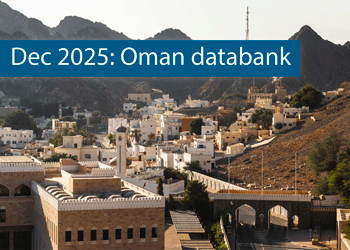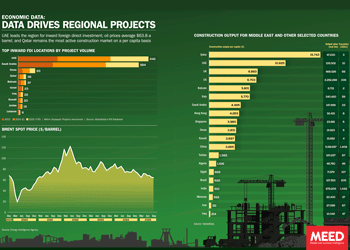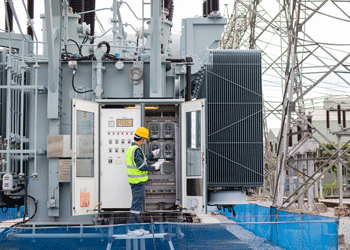Transport links stitch GCC together
25 November 2024
This package also includes: Cooperation strengthens Gulf markets
 Analysis
Analysis
Colin Foreman
Editor
Transport projects connecting the GCC have made stuttering progress over the years, with brief periods of intense project positioning typically followed by years of little progress.
These projects are crucial for intra-GCC trade, and, once built, should provide a catalyst for further economic activity.
Since the Al-Ula Accords were signed in January 2021, projects have started to move forwards again, with schemes including the GCC railway network, the GCC grid, and several other road and causeway links at various stages of planning and construction.
 GCC rail
GCC rail
For the GCC railway network, GCC leaders approved the establishment of the GCC Rail Authority in January 2022. The entity is entrusted with overall policymaking and coordination among member states to ensure the smooth delivery and operation of the scheme.
The railway will stretch over 2,177 kilometres (km), from Kuwait, through Dammam in Saudi Arabia, to Bahrain, with a causeway to be constructed between the two countries, and from Dammam to Qatar, Saudi Arabia, the UAE and finally to Muscat via Sohar in Oman.
There will be 684km of track in the UAE, 663km in Saudi Arabia, 306km in Oman, 283km in Qatar, 145km in Kuwait and 36km in Bahrain.
Passenger trains will run at 220 kilometres an hour (km/h), while freight trains will travel at 80-120km/h.
The project is expected to take a significant step forward this year with the award of the contract to prepare the operational plan study for the scheme. Speaking at the Global Rail event in Abu Dhabi on 8 October, sources told MEED that “the evaluation is in the final stages and the contract award is imminent”.
A source added that the General Secretariat of the Cooperation Council has set a deadline of 2030 for the project to be operational.
Several causeways are planned that will provide transport links between countries in the GCC. After stalling after 2010, Qatar and Bahrain have agreed to restart plans to develop the $4bn Qatar-Bahrain Causeway project. The two countries have also instructed the respective authorities to finalise plans for initiating the implementation of the project. The next step will be establishing a technical committee and appointing a consultancy to work on the designs.
The 40km-long causeway will connect the eastern coast of Bahrain to the northern region of Qatar. It will feature a dual two-lane highway and a rail link for the GCC rail network.
Once built, these transport projects should provide a catalyst for further economic activity
Construction on the project was originally scheduled to start in early 2009 after a consortium led by Vinci Construction Grands Projets signed a $3bn design-and-build contract in May 2008.
The consortium also included Qatari Diar Real Estate Investment Company, Germany’s Hochtief, Greece’s Consolidated Contractors Company and Belgium’s Deme Group.
The project was initially designed by France’s Lavigne & Cheron Architects. US-based consultant KBR was appointed as the project management consultant with support from Halcrow, which is now part of US-based Jacobs.
Further crossings
Another planned international crossing is the second causeway between Saudi Arabia and Bahrain. The $3.5bn project, which has been called the King Hamad Causeway project, was moving towards construction in 2021 when it was included in Bahrain’s $30bn Strategic Projects Plan. Since then progress has been slow, and it is understood that the authorities are re-evaluating how the project should move ahead.
The project involves building a 25km road and rail crossing linking Saudi Arabia and Bahrain. It will follow the same alignment as the existing King Fahd Causeway. It has been earmarked for delivery on a public-private partnership basis. The King Fahd Causeway Authority appointed a consortium to provide transaction advisory services in late 2019.
The $8.9m consultancy agreement was signed with a consortium of Netherlands-headquartered KPMG, US-based Aecom and UK-based CMS. The team was tasked with working on developing the financing model, the required engineering specifications and design, as well as helping with the assessment and selection of the developers.
Canada-based SNC Lavalin and UK-based consultancy firm PwC conducted the project due diligence study in 2017.
The existing King Fahd Causeway is operating at capacity. About 11.5 million cars cross the causeway every year, and the growth has been 6% per annum over the past 10 years.
Another causeway being considered is a link connecting Abu Dhabi and Qatar. The proposed link could provide road and rail access between Qatar and the UAE, bypassing Saudi Arabia, located between the countries.
The concept has been considered before. There were plans in 2005 that involved building a 40km causeway starting near Sila in Abu Dhabi emirate and extending to the south of Doha.
In the past, there have been difficulties with the route because it runs across Saudi Arabian territorial waters.
Road links
Overland road links have also been built. In 2021, a 725km-long road running through the Empty Quarter from Saudi Arabia to Oman opened. The Saudi section of the highway is 564km long, and the Oman section runs for 161km. The highway provides a link between the two countries bypassing the UAE.
When it opened, the authorities added that the road would improve trade between Oman and Saudi Arabia and give Oman access to Saudi Arabia’s Red Sea Ports. Likewise, it gives Saudi Arabia access to Oman’s ports on the Arabian Sea.

Exclusive from Meed
-
 Navigating financial markets amid geopolitical fragmentation
Navigating financial markets amid geopolitical fragmentation28 December 2025
-
 Oman’s growth forecast points upwards
Oman’s growth forecast points upwards24 December 2025
-
 December 2025: Data drives regional projects
December 2025: Data drives regional projects23 December 2025
-
 Local firm bids lowest for Kuwait substation deal
Local firm bids lowest for Kuwait substation deal22 December 2025
-
 Saudi-Dutch JV awards ‘supercentre’ metals reclamation project
Saudi-Dutch JV awards ‘supercentre’ metals reclamation project22 December 2025
All of this is only 1% of what MEED.com has to offer
Subscribe now and unlock all the 153,671 articles on MEED.com
- All the latest news, data, and market intelligence across MENA at your fingerprints
- First-hand updates and inside information on projects, clients and competitors that matter to you
- 20 years' archive of information, data, and news for you to access at your convenience
- Strategize to succeed and minimise risks with timely analysis of current and future market trends

Related Articles
-
 Navigating financial markets amid geopolitical fragmentation
Navigating financial markets amid geopolitical fragmentation28 December 2025

As we move towards 2026, geopolitical fragmentation is no longer a background risk that occasionally disrupts markets.
It has become a defining feature of the global financial landscape. Shifting alliances, persistent regional tensions, sanctions and the reconfiguration of supply chains are reshaping how capital flows, how liquidity behaves and how confidence is formed.
For firms operating in the Middle East, this does not simply mean preparing for more volatility. It means operating in a system where the underlying rules are evolving.
For much of the past three decades, businesses and investors worked within a broadly convergent global framework. Trade expanded, financial markets deepened and policy coordination – while imperfect – created a sense of predictability. That environment has changed.
Today, economic decisions are increasingly influenced by strategic alignment, security considerations and political resilience. Markets still function, but they do so in a more fragmented and less forgiving way.
Shifting landscape
One of the most important consequences of this shift is that risk no longer travels along familiar paths. In the past, geopolitical events were often treated as temporary shocks layered onto an otherwise stable system.
Today, they shape the system itself. Trade flows are influenced as much by political compatibility as by cost efficiency. Supply chains, once optimised for speed and scale, are reorganising into regional or allied clusters. Financial markets respond not only to data, but to narratives about stability, alignment and long-term credibility.
This change places greater pressure on firms that rely on historical relationships to guide decisions. Models built on past correlations – between interest rates and equity markets, or between energy prices and regional growth – are less reliable when markets move between different regimes. The challenge is not simply higher volatility, but the fact that correlations themselves can shift quickly.
Monetary policy adds a second layer of complexity. Major central banks are no longer moving in step. The US, Europe and parts of Asia face different inflation dynamics and political constraints, leading to diverging interest-rate paths.
For the GCC, where currencies are largely pegged to the US dollar, this divergence has direct consequences. Local financial conditions are closely tied to decisions taken by the Federal Reserve, even when regional economic conditions follow a different cycle.
This matters because funding costs, liquidity availability and hedging conditions are shaped by global rather than local forces. When US policy remains tight, dollar liquidity becomes more selective. When expectations shift abruptly, market depth can disappear quickly.
For firms with international exposure, long-term investment plans, or reliance on external financing, these dynamics require careful management. They cannot be treated as secondary macro considerations.
Energy markets further complicate the picture. The Middle East remains central to global energy supply, which means geopolitical events often interact with oil prices and financial conditions at the same time.
When shifts in energy expectations coincide with changes in global interest-rate sentiment, liquidity conditions can tighten rapidly. This interaction is well known in academic research on fixed exchange-rate systems, but its practical implications are often underestimated in corporate planning.
Expanding vulnerabilities
These dynamics expose clear vulnerabilities. Concentrated supply chains are more susceptible to disruption. Financing structures dependent on continuous market access are more exposed to sudden repricing. Risk management approaches that assume stable relationships between assets are more likely to disappoint. Operational risks – particularly in technology and data – are increasingly shaped by geopolitical considerations rather than purely technical ones.
At the same time, the region enters 2026 from a position of relative strength. GCC economies benefit from fiscal buffers, long-term investment programmes and a growing perception of stability compared to other parts of the world. In an environment where uncertainty is widespread, predictability itself becomes valuable. Capital increasingly seeks jurisdictions that combine economic ambition with institutional credibility.
The question, therefore, is not whether opportunities exist, but whether firms are prepared to capture them responsibly. This requires a shift in how future risks are assessed and embedded into decision-making. Linear forecasts and static plans are insufficient when the environment itself can change state. Scenario thinking must evolve beyond optimistic and pessimistic cases to reflect different combinations of geopolitical alignment, monetary conditions, and supply-chain stability. These scenarios should inform capital allocation, not sit in strategy documents.
Liquidity and risk management discipline also become central. In both trading and corporate finance, experience shows that many failures stem not from being wrong on direction, but from being overexposed when conditions change. Scaling risk to market conditions, maintaining funding flexibility and understanding how quickly liquidity can evaporate are essential practices. This is as true for corporate balance sheets as it is for trading books.
Operational resilience must be viewed through the same lens. Supply-chain redundancy, cybersecurity preparedness and data governance are no longer purely operational concerns. They influence financial stability, investor confidence and regulatory trust. In a fragmented world, operational disruptions can quickly translate into financial and reputational damage.
Facing the future
As we approach 2026, leadership in the Middle East faces a clear test. The global environment is unlikely to become simpler or more predictable. Firms that continue to rely on assumptions shaped by a different era will find themselves reacting rather than positioning. Those that invest in disciplined risk management, flexible planning and operational resilience will be better placed to navigate uncertainty and to turn volatility into strategic advantage.
In this environment, risk management is not an obstacle to growth. It is the framework that makes sustainable growth possible.
Ultimately – and this is an often overlooked critical point – none of these adjustments, whether in scenario planning, liquidity discipline, or operational resilience, can be effective without the right human capital in place.
Geopolitical fragmentation and financial volatility are not risks that can be fully addressed through models or policies alone. They require informed judgement, institutional memory and the ability to interpret weak signals before they become material threats or missed opportunities.
Firms that succeed in this environment will be those that deliberately invest in corporate knowledge: building internal capabilities where possible and complementing them with external expertise where necessary. This means involving professionals with the right background, cross-market experience and a proven, proactive approach to risk awareness and governance.
In a fragmented world, competitive advantage increasingly depends not only on capital or strategy, but on the quality of people entrusted with understanding risk, challenging assumptions and guiding decision-making under uncertainty.
 https://image.digitalinsightresearch.in/uploads/NewsArticle/15306336/main.gif
https://image.digitalinsightresearch.in/uploads/NewsArticle/15306336/main.gif -
 Oman’s growth forecast points upwards
Oman’s growth forecast points upwards24 December 2025

MEED’s January 2026 report on Oman includes:
> COMMENT: Oman steadies growth with strategic restraint
> GVT & ECONOMY: Oman pursues diversification amid regional concerns
> BANKING: Oman banks feel impact of stronger economy
> OIL & GAS: LNG goals galvanise Oman’s oil and gas sector
> POWER & WATER: Oman prepares for a wave of IPP awards
> CONSTRUCTION: Momentum builds in construction sectorTo see previous issues of MEED Business Review, please click herehttps://image.digitalinsightresearch.in/uploads/NewsArticle/15306449/main.gif -
 December 2025: Data drives regional projects
December 2025: Data drives regional projects23 December 2025
Click here to download the PDF
Includes: Top inward FDI locations by project volume | Brent spot price | Construction output
MEED’s January 2026 report on Oman includes:
> COMMENT: Oman steadies growth with strategic restraint
> ECONOMY: Oman pursues diversification amid regional concerns
> BANKING: Oman banks feel impact of stronger economy
> OIL & GAS: LNG goals galvanise Oman’s oil and gas sector
> POWER & WATER: Oman prepares for a wave of IPP awards
> CONSTRUCTION: Momentum builds in construction sectorTo see previous issues of MEED Business Review, please click herehttps://image.digitalinsightresearch.in/uploads/NewsArticle/15306140/main.gif -
 Local firm bids lowest for Kuwait substation deal
Local firm bids lowest for Kuwait substation deal22 December 2025
The local Al-Ahleia Switchgear Company has submitted the lowest price of KD33.9m ($110.3m) for a contract to build a 400/132/11 kV substation at the South Surra township for Kuwait’s Public Authority for Housing Welfare (PAHW).
The bid was marginally lower than the two other offers of KD35.1m and KD35.5m submitted respectively by Saudi Arabia’s National Contracting Company (NCC) and India’s Larsen & Toubro.
PAHW is expected to take about three months to evaluate the prices before selecting the successful contractor.
The project is one of several transmission and distribution projects either out to bid or recently awarded by Kuwait’s main affordable housing client.
This year alone, it has awarded two contracts worth more than $100m for cable works at its 1Z, 2Z, 3Z and 4Z 400kV substations at Al-Istiqlal City, and two deals totalling just under $280m for the construction of seven 132/11kV substations in the same township.
Most recently, it has tendered two contracts to build seven 132/11kV main substations at its affordable housing project, west of Kuwait City. The bid deadline for the two deals covering the MS-01 through to MS-08 substations is 8 January.
https://image.digitalinsightresearch.in/uploads/NewsArticle/15305745/main.gif -
 Saudi-Dutch JV awards ‘supercentre’ metals reclamation project
Saudi-Dutch JV awards ‘supercentre’ metals reclamation project22 December 2025
The local Advanced Circular Materials Company (ACMC), a joint venture of the Netherlands-based Shell & AMG Recycling BV (SARBV) and local firm United Company for Industry (UCI), has awarded the engineering, procurement and construction (EPC) contract for the first phase of its $500m-plus metals reclamation complex in Jubail.
The contract, estimated to be worth in excess of $200m, was won by China TianChen Engineering Corporation (TCC), a subsidiary of China National Chemical Engineering Company (CNCEC), following the issue of the tender in July 2024.
Under the terms of the deal, TCC will process gasification ash generated at Saudi Aramco’s Jizan refining complex on the Red Sea coast to produce battery-grade vanadium oxide and vanadium electrolyte for vanadium redox flow batteries. AMG will provide the licensed technology required for the production process.
The works are the first of four planned phases at the catalyst and gasification ash recycling ‘Supercentre’, which is located at the PlasChem Park in Jubail Industrial City 2 alongside the Sadara integrated refining and petrochemical complex.
Phase 2 will expand the facility to process spent catalysts from heavy oil upgrading facilities to produce ferrovanadium for the steel industry and/or additional battery-grade vanadium oxide.
Phase 3 involves installing a manufacturing facility for residue-upgrading catalysts.
In the fourth phase, a vanadium electrolyte production plant will be developed.
The developers expect a total reduction of 3.6 million metric tonnes of carbon dioxide emissions a year when the four phases of the project are commissioned.
SARBV first announced its intention to build a metal reclamation and catalyst manufacturing facility in Saudi Arabia in November 2019. The kingdom’s Ministry of Investment, then known as the Saudi Arabian General Investment Authority (Sagia), supported the project.
In July 2022, SARBV and UCI signed the agreement to formalise their joint venture and build the proposed facility.
The project has received support from Saudi Aramco’s Namaat industrial investment programme. Aramco, at the time, also signed an agreement with the joint venture to offtake vanadium-bearing gasification ash from its Jizan refining complex.
Photo credit: SARBV
https://image.digitalinsightresearch.in/uploads/NewsArticle/15305326/main.gif

